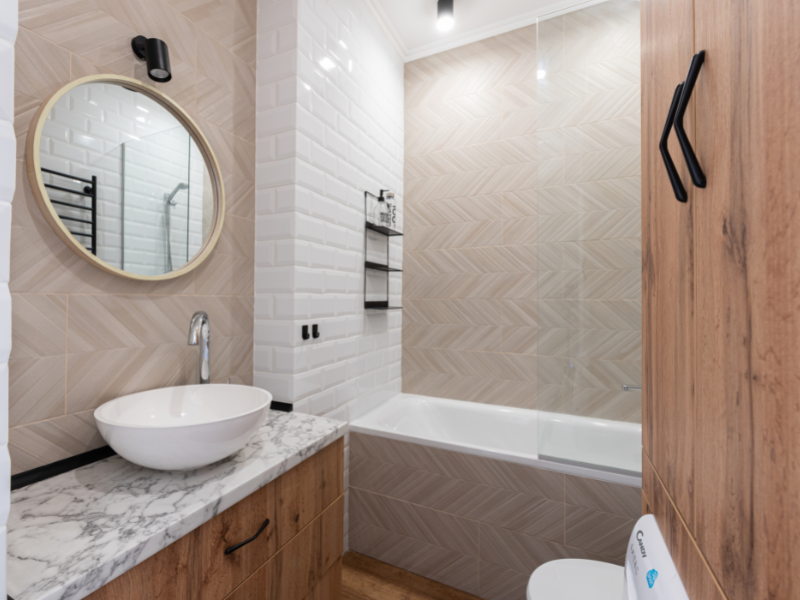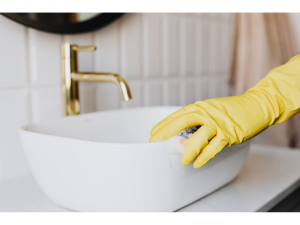For many homeowners, a flooded washroom can seem like an incredibly big deal. There’s a layer of water all over the floor, soaking into your bath mats and making each step you take result in a loud “slosh” noise.
In more drastic cases, the water might even leak outside of your bathroom, increasing the potential risk of the water damaging any wood walls or floors you have. Regardless of the cause of the flooded bathroom, it’s important to keep calm.
Most of the time, a bathroom flood is surprisingly common and keeping calm can often ensure that you can act quickly in minimizing any damage that the water might cause. With a calm mind, you can go about taking the appropriate steps needed in order to remove the water and also fix any leaks or broken pipes that may have caused it.
If you find your bathroom flooded, it’s important to call a plumbing company, like Clover Contracting to fix any broken piping for you. Doing this will reduce the chances of any more damage occurring. However, you should also follow these steps and stop any more water damage, if your flooded bathroom has another cause.
What can cause bathroom flooding?
There are a few different reasons that your bathroom could have flooded. As it is with many plumbing related issues, one of the main causes that lead to a room flooding is a pipe bursting in the space.
When dealing with a flooded bathroom, there’s also the chance that the toilet has a clog further down into the plumbing system, and each flush only causes more water to back up and out of the toilet.
Finally, the cause could simply be that one of the bathroom’s faucets was leaking or left on without any way to drain it.
Turn off the water
The first and most important step is to shut the water off.
If the main cause of the bathroom flooding is a broken pipe or a leaking faucet, shutting the water off first ensures that you can easily clean up the water. Depending on where the water is, any water that’s in the tub or showers can drain away as well, further helping you.
Additionally, fixing a leaky shower head or tap is significantly easier when you don’t need to worry about water sloshing over your hands and making it hard to properly fix the issue.
Turn the power to your bathroom off
One of the most steps you need to do when clearing out and dealing with a bathroom flood is to turn the power off to the bathroom and its surrounding area. This includes removing any electrical items that you may have that close to the water, including hair straighteners and space heaters.
If anything is plugged in, first make sure that the outlets that the items are connected to aren’t damaged or otherwise exposed to the water. While it isn’t likely that a flooded bathroom is a particularly dangerous electrical hazard, your safety should always take priority.
Remove any standing water
As with most water spills, getting rid of the remaining standing water is the next step that you need to take.
Smaller puddles of water can easily be cleaned up with sponges and paper towels. If you have enough to spare, using regular hand and bath towels can also work just as well without the need to toss out or flush a lot of paper.
For larger amounts of water, a mop and bucket works best. However, if you want the most efficient way to get rid of the water in the flooded bathroom, you can rent a wet vac from your nearest home improvement store.
Check for any wet spots on your walls or cabinets
Your bathroom flooding can often lead to some water damage to the walls and any floor cabinets.
As a result, make sure you check them to see if there are any wet or damp areas. Due to how drywall is made and installed, any water that accidentally gets absorbed will more than likely spread up towards the ceiling.
While you might be able to just replace the damp areas, replacing entire sections or even the whole wall may be needed. If any moisture remains, it can lead to a loss in structural integrity as well as a higher risk of mold growing in the damp environment.
Disinfect the bathroom
Depending on what caused the bathroom flood, disinfecting the surfaces can greatly help you and your family. Standing water can be a breeding place for more than mold to grow and with the water soaking into wood and sometimes even the mortar between tiles, bacteria can grow there.
Even before flooding, bathrooms are considered to be one of the more unclean areas in a house. By disinfecting the bathroom’s main surfaces, you clean out any remaining bacteria and other contaminants while making it safer to use the bathroom again.
On the plus side, many cleaners and disinfectants also make your bathroom smell nicer!
Dry your bathroom out
As a small bit of additional safety, drying the bathroom out can also be one of the many steps you can take when you find your bathroom flooded.
Once all the water is gone and all of your electronics are out, drying the bathroom can get rid of the moisture that lingers in the air. Any parts of the walls, ceilings and cupboards that weren’t directly wet can gain quite a bit from ensuring that nothing can grow there. Additionally, any tile flooring can gain a similar benefit while also making sure that you can use it if need be.
Takeaway
Finding your bathroom flooding can be one of the most terrifying things a homeowner can see.
However, it’s important to stay calm and quickly get rid of anything that can cause damage to you or the house. Always begin by ensuring that you won’t get hurt while clearing out the water, even using rubber soled shoes if the floors are too wet. Shut off any faucets that may be the cause or shut off the water to the bathroom if you can before starting to fix the plumbing issue.
However, if the main cause of the bathroom flooding is a broken pipe, leave any repairs to Clover Contracting.




